The development of healthy human intestinal flora before the age of 5
- Normal Liver Cells Found to Promote Cancer Metastasis to the Liver
- Nearly 80% Complete Remission: Breakthrough in ADC Anti-Tumor Treatment
- Vaccination Against Common Diseases May Prevent Dementia!
- New Alzheimer’s Disease (AD) Diagnosis and Staging Criteria
- Breakthrough in Alzheimer’s Disease: New Nasal Spray Halts Cognitive Decline by Targeting Toxic Protein
- Can the Tap Water at the Paris Olympics be Drunk Directly?
Cell Host & Microbe: The development trajectory of healthy human intestinal flora before the age of 5
The development of healthy human intestinal flora before the age of 5. Some types of microflora related to human health are acquired in late childhood and have not reached the level of adult intestinal tract at the age of 5.
Guide
The intestine is a dense ecosystem in which the intestinal flora is established at birth. However, the succession process of different bacteria being incorporated into the intestinal flora is still relatively unknown.
In this article, researchers used 16S rRNA gene sequencing analysis to analyze the intestinal flora of 471 Swedish children from birth to 5 years old, and collected children 4 months, 12 months later, 3 and 5 years old, and these A sample of the mother when the child was born.
Researchers also compared their intestinal flora with the Swedish adult population. Researchers found that the level of flora followed four different colonization patterns during the establishment process. Methanobrevibacter and Christensenellaceae were colonized late, and the flora did not reach adult levels at the age of 5 years.
These late colonization of bacteria are associated with increased alpha diversity in children and adults. By tracking the characteristics of children’s different age groups, researchers have observed that the development trajectory of children’s intestinal flora is individual dynamic.
Paper ID
- Original name: Developmental trajectory of the healthy human gut microbiota during the first 5 years of life
- Journal: Cell Host & Microbe
- IF: 15.923
- Publication time: 2021.3.31
- Corresponding author: Fredrik Bäckhed
- Corresponding author unit: Institute of Medicine, Sahlgrenska College, University of Gothenburg, Sweden
Results:
1. The abundance and composition of intestinal flora in children under 5 years old
Researchers have expanded the previous study to increase the number of children (n=471), and followed them in the first 5 years after birth to investigate the establishment of intestinal flora. Researchers sequenced the V4 region of the 16S rRNA gene for the first week of birth (n = 246)), 4 months (n = 411), 12 months (n = 397), 3 years old (n = 336) and 5 Samples aged (n = 288) were collected (Table 1).
Researchers also collected samples of the intestinal flora of 357 mothers after childbirth. Researchers compared the results with 101 stool samples from Swedish normal adults (50-64 years old) in the Swedish SciLifeLab SCAPIS Wellness Profiling (S3WP) study, and identified 1,434 operational classification units (OUT). The α diversity of the intestinal flora of infants and young children increases with age, but at the age of 5, its diversity is still lower than that of adults (p = 4.6⋅10−5; Figure 1A). Since the mother’s intestinal flora does not represent the flora of normal adults, Researchers use S3WP adult flora for further analysis and comparison.
Table 1. Descriptive data of the study population
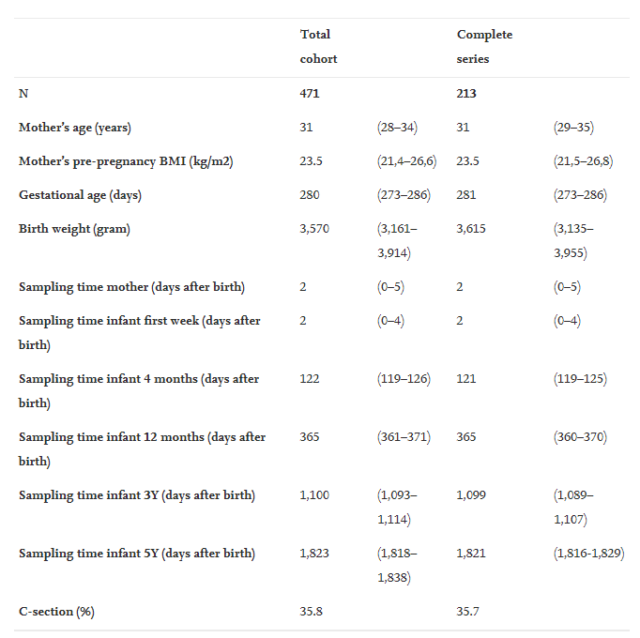
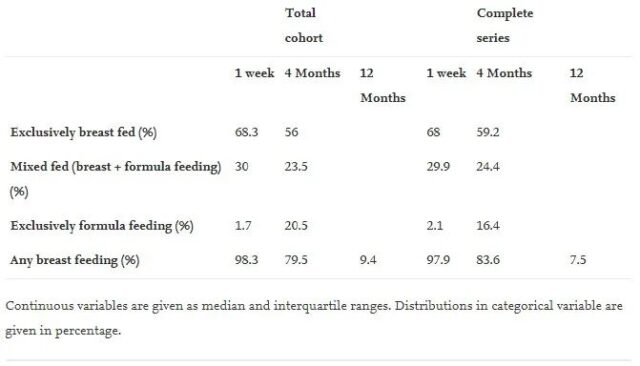
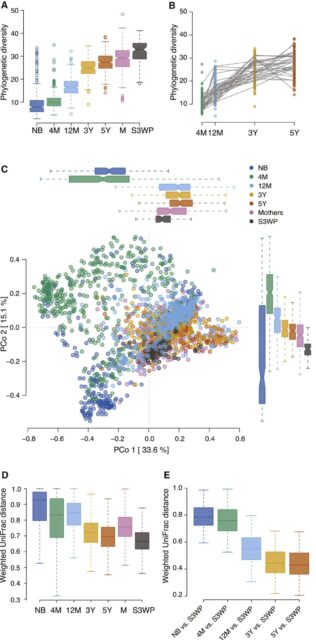
Figure 1. Compared with adults, the development of intestinal flora from newborn to 5 years old. (A) Alpha diversity (species diversity) measured by Faith PD in the total cohort (n = 471) of newborns (n = 246), 4 months (n = 411), and 12 months (n = 397) ), 3 years old (n = 336), 5 years old (n = 288), mother (n = 357) and Swedish SciLifeLab SCAPIS Health Analysis (S3WP) adults. (B) The longitudinal development of α diversity measured by the gray scale of 35 randomly selected children (from 4M to 5Y), expressed in Faith’s PD; time is an important factor in the linear mixed-effects model, p <2.2×10 -16, n = 213. (C) The first and second principal coordinates of the dimensionality reduction of the weighted UniFrac metric in the total cohort (the values in parentheses indicate the total variance explained by the principal coordinates). (D) The statistical data in Table S1C shows the statistical data of the weighted UniFrac measurement in the entire cohort of children and adults in the age group. (E) Weighted UniFrac metric between age group and S3WP adults.
In order to better simulate the longitudinal development of the intestinal flora in each child, Researchers conducted a sub-analysis of 213 children between 4 months and 5 years old. the result shows, Diversity increases significantly with age, with an average increase of 3.9±0.1 units of phylogenetic diversity per month (p <2.2⋅10−16) (Figure 1B).
The weighted UniFrac analysis of all samples showed that the overall composition of the intestinal flora has changed significantly at different ages, similar to the increase in the number of adult flora as children age (Figure 1 C-1E) ). However, at the age of 5, there are still significant differences in the composition of the intestinal flora of children compared to mothers and adults. Intestinal flora changes the most at 4-12 months, age explains 23% of its total variance, while age between 12 months and 3 years only explains 5%, and between 3-5 years old it explains 0.9%. (Block diagram in Figure 1C).
Therefore, compared with adults, the microflora of 4-month and 12-month-old infants are highly heterogeneous, and the difference is greatest compared with adults, but the intestinal flora of 3-year-old and 5-year-old infants is more similar to that of adults (Figure 1 D -1E).
2. Intestinal dynamics and characteristics of intestinal flora in children from 4 months to 5 years old
In order to further characterize the dynamics of intestinal flora development, Researchers used time course analysis to classify the relative abundance of microbial genera and analyzed a complete sample of 213 children from 4 months to 5 years old. The analysis identified four main trajectories of each genera in the developing gut flora:
(1) the genera with the highest relative abundance at 4 months;
(2) the genera with the highest relative abundance at 12 months;
(3) Genus whose relative abundance increases rapidly between 4 and 12 months and reach a stable level within 3 years;
(4) The relative abundance of the genera increases after 12 months, and the relative abundance increases between 3 and 5 years old. The time continues to increase (Figure 2A).

Figure 2. The abundance of microbial genera during the development of the gut microbiota for up to 5 years.
(A) The median abundance of microbial genera was estimated using a mixed-effect model of 4 months, 12 months, 3 years and 5 years in the longitudinal cohort (n = 213).
(B-E) (B) the first trajectory,
(C) The second trajectory,
(D) The third trajectory and
(E) Examples of representative genera of the fourth trajectory.
Starting from (E), (F) each time point in the total queue and the S3WP queue is a horizontal situation.
3. Community types of different age groups
Next, Researchers use Dirichlet Multiple Mixtures (DMM) to test whether the intestinal flora of children of different ages aggregate into different community types according to age. Researchers have identified 14 colony types: there are 3 types (NB 1,2,3) in the newborn sample, 4 common types (4M 1,2,3,4) at 4 months, from 12 months There are 3 population types (12M 1,2,3) in the starting samples, 3 population types (Child 1,2,3) are common in the samples of 3-year-old and 5-year-old children, and 1 common in adult samples Community type (Figure 3A).
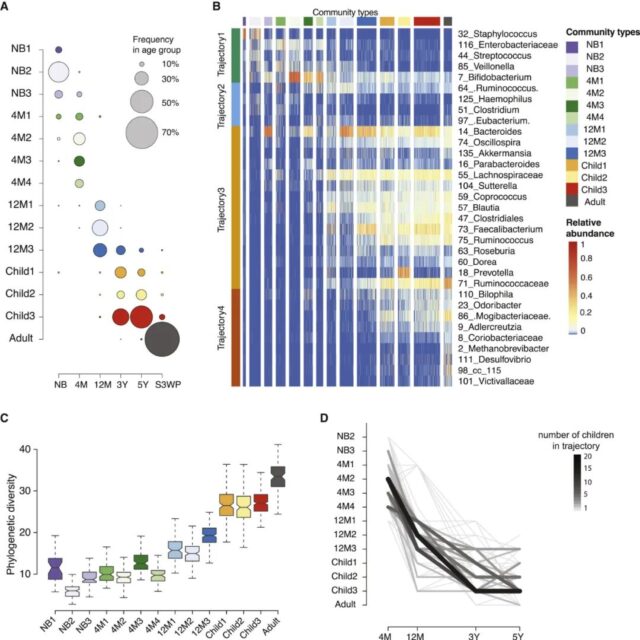
Figure 3. The intestinal flora develops through age-specific community types. (A) The distribution of the sample in the 14 identified community types (y-axis) (n = 471). (B) A heat map of the relative abundance of the community types that belong to (row), sorted by the trajectory they belong to. (C) Box plot of α diversity (measured by Faith’s PD), distributed among 14 community types. (D) Conversion between community types in a cohort with a complete set of samples (n = 213).
As expected, at each age stage, the general community structure is dominated by genus, with its own colonization and establishment of trajectory patterns. Specifically, the community types of newborns and 4-month-old infants conform to trajectory 1 (Figure 2B), the community type at 12 months of age conforms to trajectories 2 and 3, and the community composition at 3 and 5 years of age conforms to trajectories 3 and 4 ( Figure 3B).
Compared with 5-year-old children, the abundance of genus-level flora in adult populations is higher. As expected, and consistent with the data in Figure 1A, the community type with the lowest α diversity is dominated by newborns.
- The most diverse community type is dominated by adults. In the samples of the same age group, the difference between the community types was also observed.
- Diversity difference. Further analysis found that the community type divided by α diversity is 12M, of which
- The most diverse community type is 12M3, in which Faecalibacterium and unclassified Ruminococcaceae have higher abundance, and Ruminococcus gnavus of this community type is also lower. In addition, the community types of 3-year-old and 5-year-old children were distinguished by differences in the abundance of Prevotella, Bifidobacterium, and Bacteroides.
4. Intestinal flora developing into adult communities
To further study the developmental trajectory, Researchers performed a similar analysis on the sub-cohort of the complete series of samples (n = 213). The alpha diversity at the 12th month was positively correlated with the alpha diversity at 5 years old (Spearman correlation, rho = 0.32, p = 1.5⋅10−6). 12M children
The diversity of community types decreased over time, while the diversity of Child 3 type children’s community types increased over time (Figure 3A). But there are also a few children who have relatively immature community types at the age of 5, that is, their flora has a community type with 12M characteristics. Part of the intestinal flora of these children was also classified into a community type of 12M at the age of 3, which indicates that there is individual dynamics in the development trajectory of the intestinal flora of children, but no flora reduces its alpha diversity over time Sex. From the trajectories of bacterial flora development in children aged 4 months to 5 years (Figure 3D), Researchers identified the most common trajectories.
5. Bacteria associated with alpha diversity in the adult and developing intestines
Since Researchers observed that alpha diversity is closely related to the development and maturity of the flora, Researchers next studied which bacteria are associated with alpha diversity at different ages. Among the 12M type samples, several OTUs related to the increased diversity belonged to Faecalibacterium, and the others belonged to unclassified Clostridia, and had a high degree of recognition for Eubacterium rectale (Figure 4A). Interestingly, the OTU of Ruminococcus gnavus at all ages is negatively correlated with α diversity, and will decrease over time, resulting in a significantly lower abundance of adult flora than 5-year-old children (Figure 4B) , Researchers further determined that Ruminococcus gnavus is a marker of immature flora in children and adults.
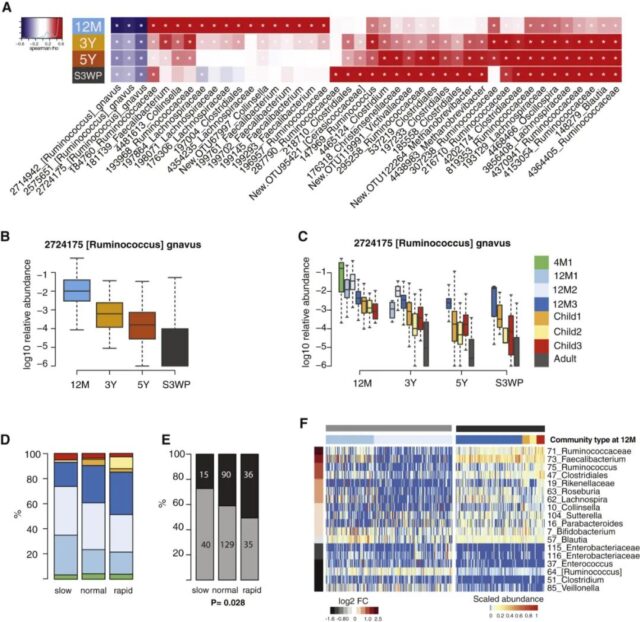
Figure 4. OUT associated with low community abundance is consistent in children and adult flora, increasing in low diversity community types at all ages.
(A) The OTUs heat map is significantly correlated with the abundance of the community within the time point.
(B) The relative abundance of OTU 2724175 at different ages.
(C) The relative abundance of Ruminococcus gnavus OTU 2724175 distributed among different age groups. (D) At 12 months (12M), the distribution of community types among the three weight gain development groups.
(E) The three weight gain development groups have low (low, 12M1+12M2) alpha diversity and high (high, 12M3, Child 1,2,3) alpha diversity community distribution at 12 months .
(F) After correcting the false discovery rate using the Wilcoxon rank sum test, the high group (community types 12M3, Child1, Child2, and Child3) and low group (12M1 and 12M3) have significant differences in sample abundance at 12M (n = 376) The L6/genus horizontal heat map.
6. The relationship between intestinal flora and growth and development
Researchers then investigated how the composition of the 12M flora in the cohort affects the weight development of the children over the next 4 years. Children whose weight gains are slower than expected (defined as a change> -0.67 standard difference number (SDS) based on the growth reference curve between 12 months and 5 years old) at 12 months, compared with children with normal or faster weight development The diversity of the community types (12M1 and 12M2) is lower than that (Figure 4D and 4E, Fischer test; p = 0.028, odds ratio 1.99, 95% CI (1.03-4.04)). In the low-diversity microbiome structure (community types 12M1 and 12M2), the relative abundance of unclassified Ruminococcaceae, Faecalibacterium and Roseburia is lower than that of the mature microbiome (Figure 4F), which indicates These communities are a more diverse flora marker, and they are associated with normal weight gain.
7. Factors affecting the early lifestyle of the intestinal flora
The longitudinal design of our study allows investigating how early life factors affect the microbiota at 5 years of age. Researchers and others have previously demonstrated that the way of delivery has a profound effect on the intestinal flora of children under one year of age. Here, the mode of delivery has a great influence on the composition and community type of the intestinal flora of newborns and infants, as well as the transition between the neonatal community types at 4 months (Figure 5A).
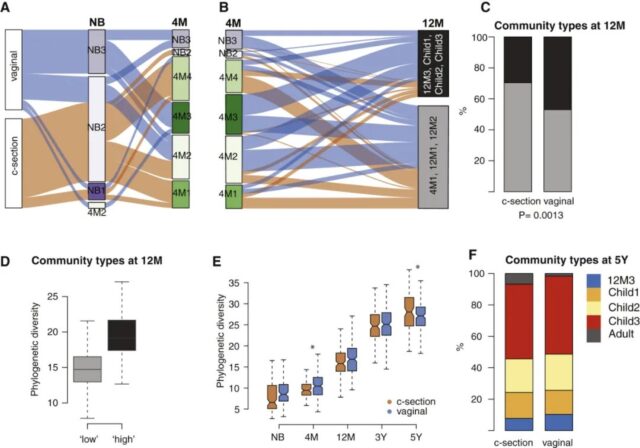
Figure 5. The effect of delivery methods on the intestinal flora can be up to 5 years. (A) Conversion between the frequency and time point of birth patterns of newborn (NB) and 4M community types (n = 227). (B) The frequency and time points of birth patterns of NB, 4M and 12M community types (n = 347). (C) Among children born by vaginal delivery and caesarean section, the frequency of children in the “low” and “high” group types at 12 months. (D) Children whose community types are “low” and “high” at the 12M time point Diversity. (E) Alpha diversity as measured by PD measured at each time point according to birth pattern. (F)Community type frequency of children born under vaginal delivery and cesarean section at age 5.
Researchers observed a pattern of birth-specific transitions between the 4-month and 12-month-old community types and a higher cesarean section rate (12M1 and 12M2) in the community types with low alpha diversity (Fischer’s exact test) , P = 0.0005, Figure 5 B-5D).
However, there is no significant transitional representation in the transition from a specific community type at 4 months to a low diversity community type at 12 months, regardless of whether it is a child born by cesarean section (Fischer’s exact test, p = 0.65) The child was also delivered vaginally (Fischer’s exact test, p = 0.12; Figure 5B).
In a cross-sectional comparison using all samples, the alpha diversity of infants delivered by caesarean section was lower at 4 months, but tended to be normal at 3 years of age, and even higher at 5 years of age (Figure 5F).
Therefore, the number of “adult” community types of 5-year-old children accounted for an excessive proportion of children undergoing cesarean section (Fischer’s test, p = 0.039, Figure 5F). Researchers also observed that there are significant differences in the relative abundance of 25 genera between 5-year-old children born by cesarean section and normal delivery.
Discusion
In this study, Researchers described the development of the gut microbiota of 471 normal Swedish children from birth to 5 years old, to extend the previous study, showing that the gut microbiota has an adult-like structure when children are 5 years old. , But its abundance is still low, and it misses some key flora that exist in the adult intestine. Our findings highlight the possibility that the flora may be particularly sensitive to interference factors in the early establishment process, which may have a profound impact on future health.
Researchers observed the age-specific flora types at each time point under 3 years old, thus confirming the significant development of intestinal flora in the first few years of life. When children start to eat solid food, a more complex microbiota appears. The related microbiota is common in adults and is defined as locus 3. After weaning, the abundance of Methanogens (such as Methanobrevibacter) first increased (Maczulak et al., 1989), which is consistent with our findings. In addition, Methanobrevibacter and Desulfovibrio are hydrogen consumers and are colonized according to trajectory 4, which may enhance fermentation potential by reducing the amount of hydrogen that inhibits the fermentation process.
As previously observed in 3-year-old children and school-age children, Researchers determined that the differences in community types at 3 and 5 years old are in Bacteroides, Prevotella, and Bifidobacterium. However, by including adults in our cluster analysis, Researchers not only found a small number of 5-year-old children and adults clustered, indicating that their intestinal flora is more mature relative to their age, and some adults have more flora than theirs. Age is expected to be even more immature. The OTUs of different bacteria are related to the alpha diversity at 12 months, 3 years, 5 years and adults. The high alpha diversity is associated with several unspecified Clostridiales, Methanobrevibacter, Christensenellaceae, and the lower abundance of R. gnavus in the microflora of children and adults, which is related to Over time, the conclusion that the abundance of R. gnavus has decreased is consistent.
Compared with malnourished children, the microbiota of malnourished children is immature. Researchers did not include clinically malnourished children in our study, but it can be observed that children with a lower-than-expected weight gain between 12 months and 5 years old have less mature gut microbiota at 12 months, although This is much more pronounced than in Malawi and Bangladesh’s clinically malnourished children. However, similar to malnourished children, the Faecalibacterium and Ruminococcus groups of Swedish children with lower weight gain have reduced abundance. Importantly, since our results are based on relative abundance, Researchers cannot rule out that the significant increase or decrease in abundance of a particular taxa may be due to the change in the total bacterial load in the stool samples of children.
There have been a large number of reports on the influence of delivery methods on the composition of gut microbes in the first year of life. In addition, the mode of delivery may also be related to the occurrence of allergies and obesity, which may be caused by affecting the microbiota in the key window during the development of the immune system after birth. Consistent with this, Researchers have found in the published literature that the mode of delivery has a great influence on the intestinal flora in the early stages of life, although it can still significantly explain the changes in the composition of the intestinal flora at 3 and 5 years of age. , But this impact is very small. Cesarean section is associated with lower alpha diversity at 4 months, which is consistent with previous observations. Researchersalso observed that when the cesarean section children are in the transitional stage of the flora, that is, when they are 12 months old, their alpha diversity is low and they are in the majority of this type. However, these differences normalized as the intestinal flora continued to mature. In the future, when the intestinal flora may be particularly sensitive to the development of diseases, a larger scale of research is needed to determine the potential development window. In addition, reanalysis and meta-analysis of previously published data sets using amplicon sequence variation may help to identify important taxa independent of the reference database.
Conclusion
In this study, Researchers used a longitudinal birth cohort to describe the development of human intestinal flora in the first 5 years of life. Researchersconcluded that some types of microflora related to human health were acquired in late childhood and did not reach the level of adult intestinal tract at the age of 5 years.
In addition, Researchers have observed that the intestinal flora of children in the normal population develops at an individual rate along the development trajectory of the flora, thus emphasizing the importance of considering the dynamics of the flora.
(source:internet, reference only)
Disclaimer of medicaltrend.org



